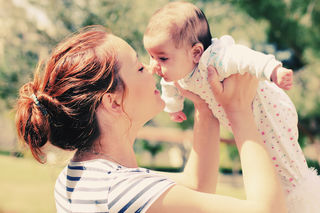Attachment
The Worst Idea in the World
"Attachment parenting" misconstrues the whole purpose of attachment.
Posted July 11, 2012 Reviewed by Davia Sills

That most powerful of engines of human development, the emotional attachment between parent and child, begins in the earliest days of infancy and endures well into adulthood. But so distorted has child-rearing become in the U.S. that the entire enterprise of attachment has been subverted.
Instead of viewing it as nature's built-in method for liberating kids, providing a means of security that allows them to explore the world, we have come to find in attachment an excuse for tethering them ever more tightly to Mom. The concept and practice of “attachment parenting,” I believe, is one of the worst ideas in the world. It is certainly one of the most unnecessary.
“Attachment parenting” is odious from the get-go, because it brands parenting. It creates two classes of parents: parents, and that higher breed of parent, attachment parents. It sets the stage for the outrageous judgmentalism that marks discussions of parenting issues in the U.S.
Unless you're practicing attachment parenting—“wearing” your baby, sleeping with your baby in your bed, and, as reflected in a recent Time magazine cover story, breast-feeding until a child is 3 or even older—you're not demonstrating sufficient love for your child. It's become an instrument with which highly educated women bludgeon each other in pursuit of the top prize in the parenting sweepstakes.
Further, it suggests that parents have to do something special to form an attachment to a child and the child to them, as if babies and parents didn't arrive at their very first meeting with neural and emotional incentives to attend to each other. As if the attachment doesn't normally happen on its own, when in fact the means are tucked inconspicuously into the mundane routines of caring for an infant.
How did the human race possibly survive the millions of years before some doctor—a doctor!—foisted the notion of attachment parenting on a nation of women already worried about doing all in their power to guarantee the future success of their children?
But most of all, “attachment parenting” is odious, because it completely misconstrues the function of attachment. The whole purpose of attachment—and the condition under which its existence can be verified—is separation. The goal of attachment is to provide a strong enough sense of security so that the child can go off and explore the world on his own. In fact, the attachment system isn't even activated unless separation occurs.
While the bond of mother to child normally gets off to a quick start—propelled internally by hormones as well as externally by holding and feeding and eye contact with an adorable creature—the attachment of child to parent forms over the first year of life. First in physical reality, gradually in an internalized image, the attachment figure becomes for the infant a source of security, a bonafide source of comfort in times of stress, and a resource of stability and support enabling him to gradually move out into a wider world.
In the beginning, physical proximity is necessary for the child to get his needs met. But as the child grows, physical proximity is progressively less necessary.
If there is magic to attachment, it is that it swings into gear completely on its own, without much fanfare. It doesn’t require custom-made nursery furniture or cashmere swaddling blankets. It grows unceremoniously, spontaneously, naturally, while other things are going on—a warm hand placed comfortingly on a baby’s belly as her diaper is changed, a gaze of affection during feeding, a smile or an expression of surprise elicited and returned. The reliability of care gets engraved into the nervous system and becomes the cornerstone of a child’s sense of security.
The importance of this transformation can’t be overstated. The internal representation of the caregiver has powers that a real parent could not possibly have. It is portable, therefore potentially always present. It is flexible, applicable to all kinds of uncomfortable situations. And it can be conjured on demand. In fact, it must be, for development to proceed. Eventually, the internal representation is even more important than the actual parent. It is the secret agent of resilience in the face of future adversity.
But for it to be engaged, for this ever-present parent-within to do the critical work that needs to be done, separation is absolutely necessary. The internal representation is an ingenious way of continuing the parental relationship while according the child freedom to move about the world. It is the long leash of development. Separation isn’t merely a test of attachment; it’s the goal, the raison d’etre.
Attachment parenting encourages parents to misread a child’s cues. It fails to recognize the baby’s need for experiences of her own, for mini-tastings of independence. It puts the parent’s desire for continued closeness ahead of the child’s needs for independent exploration. Breastfeeding looks good at age 5 because it kept a child close at 9 months. Through the misguided idea of attachment parenting, American parents overvalue eternal proximity.
A lot of ink has been spilled on the big stall called, abominably, adultescence, the failure of young people to make the leap into independent adulthood. But parents are at least equally stuck, unwilling to let kids make that leap. It's time to abandon the idea of attachment parenting.




